Colour and Bioluminescence in fish
1/45
There's no tags or description
Looks like no tags are added yet.
Name | Mastery | Learn | Test | Matching | Spaced |
|---|
No study sessions yet.
46 Terms
What are the 2 kinds of colour?
Biochromes
-From pigments
Schematochromes (structural colours)
-From reflection
What are the cells responsible for colour?
Chromatophores
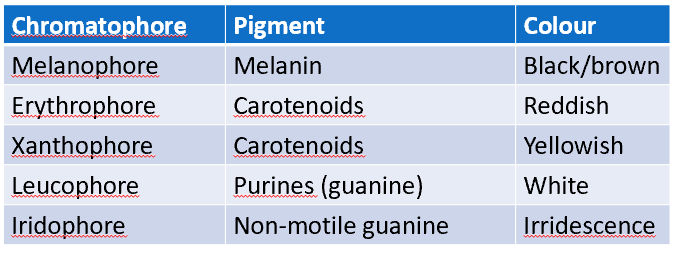
Chromatophores characteristics
-Found mainly in skin
-Occasionally subdermally
-Characterised by irregular shapes with branched processes
Chromatosome
many chromatophores intertwined or overlaid
2 types of colour change?
Physiological colour change & Morphological colour change
Physiological colour change
Short-term movement of pigment within chromatophore
Causes of physiological colour change
-Response to background colour
-Response to social, behavioural or chemical stimuli
-nervous or hormonal control
What did Logan et al (2006) investigate?
This study explores the regulation of pigmentation in zebrafish melanophores, focusing on hormonal control, intracellular signaling, and pigment translocation mechanisms.

Key points of Logan et al (2006)
Hormonal Regulation of Pigment Dispersion
-Melanin-concentrating hormone (MCH) causes pigment aggregation, leading to lighter skin tones.
-Melanocyte-stimulating hormone (MSH) induces pigment dispersion, resulting in darker pigmentation.
Intracellular Signalling Mechanisms
-Cyclic adenosine monophosphate (cAMP) is essential for controlling pigment movement within melanophores.
-Changes in cAMP levels dictate whether melanin disperses or aggregates.
Role of Cytoskeletal Elements
-Microtubules are crucial for both pigment dispersion and aggregation, supporting intracellular transport.
-Microfilaments primarily influence pigment aggregation rather than dispersion.
Zebrafish as a Model for Pigmentation Studies
-Zebrafish serve as a valuable model organism for studying physiological colour change and pigmentation regulation.
-Their pigment regulatory pathways offer insights into melanogenesis in other vertebrates, including mammals.

What did Burns et al (2024) investigate?
This study examines rapid colour change in striped marlin (Kajikia audax) during group hunting of schooling prey, revealing how these predators use visual signalling to coordinate attacks.
Key points of Burns et al (2024)
Colour Change as a Hunting Signal
-Striped marlin brighten their lateral stripes just before attacking prey.
-After striking, they return to a non-bright state, signalling the next marlin to attack.
Coordinated Group Hunting
-Marlin take turns attacking schooling sardines, ensuring efficient prey capture.
-Their colour changes act as visual cues, preventing collisions between group members.
Dual Function of Colour Change
-The brightening effect may confuse prey, making it harder for sardines to track individual attackers.
-Colour signals help predators coordinate their strikes while disrupting prey perception.
Evolutionary & Ecological Significance
-This behaviour enhances hunting efficiency, making striped marlin effective pelagic predators.
-The findings suggest visual communication plays a crucial role in predator-prey interactions.
Morphological colour change
Long-term due to change in number or type of chromatophores
-Migration
-Life history stages
Functions of colouration
-Protection of CNS from UV in larvae
-Aid to thermoregulation
-Optical filter
-Intra and Inter specific signalling
Types on intra-specific signalling
Social signals
-Recognition of individuals in schools, or juvenile/adult recognition
-Threat or waring
Sexual signals
-Identification of opposite sex in dimorphic spp
Types of inter-specific signalling
-Background matching
-Countershading
-Obliterative colouration
-Disruptive colouration
Examples of fishes background matching and their colour
Fish on sand substrate = brown
Fish in weeds/rocks (Esox lucius) = green/brown
Pelagic fish (Clupea harengus) = silvered
Demersal colouration
Ability for fish to blend into seabed (lfatfish)
Vegetal colouration
Imitates vegetation, often associated with shape
-Leafy sea dragon
-Juvenile batfish mimicking dead leaf
Countershading mechanisms
Darkens the dorsal surface and becomes progressively lighter as the intensity of the shadow increases
Shape of fish and countershading (small pelagic shoaling species)
Laterally compressed

What 2 layers silvering arise from?
Stratum Argenteum
-thick layer of guanine crystals subdermally along, flanks, parallel to body surface
Iridophores
-Non motile guanine crystals act as iridescent plates
How are iridophores oriented and act?
Vertically and act like thousand of tiny mirrors
2 types of mimicry
Mullerian mimicry & Batesian mimicry
Mullerian mimicry
Toxic/unpalatable animals that use similar colour and patterns to help teach potential predators to avoid them
Batesian mimicry
Non-toxic animals use similar colour and pattern to imitate toxic animals to gain some protection from predators
What is the other only animal that is known to show facultative mimicry?
Plagiotremus rhinorhynchos (blue striped fangblenny)
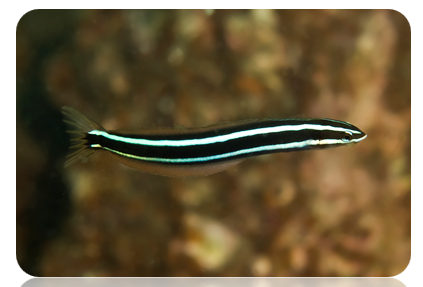
Facultative mimicry
Ability to switch on mimic colouration at will, or change appearance to mimic a variety of species
Who does Plagiotremus rhinorhynchos (blue striped fangblenny) mimic?
Labroides dimidiatus (juvenile cleaner fish)
Types of facultative mimicry Plagiotremus rhinorhynchos (blue striped fangblenny) shows?
Aggressive mimicry
-Instead of cleaning fish, it attacks them, removing scales and dermal tissue
Protective mimicry
-Non mimic form, it often found associated with shoals of differently coloured fishes and appear to closely match the colour of their companions
What did Cheney et al (2008) investigate?
This study explores facultative mimicry in coral reef fish, specifically how blue striped fangblennies (Plagiotremus rhinorhynchos) dynamically adjust their coloration to resemble juvenile cleaner fish (Labroides dimidiatus).
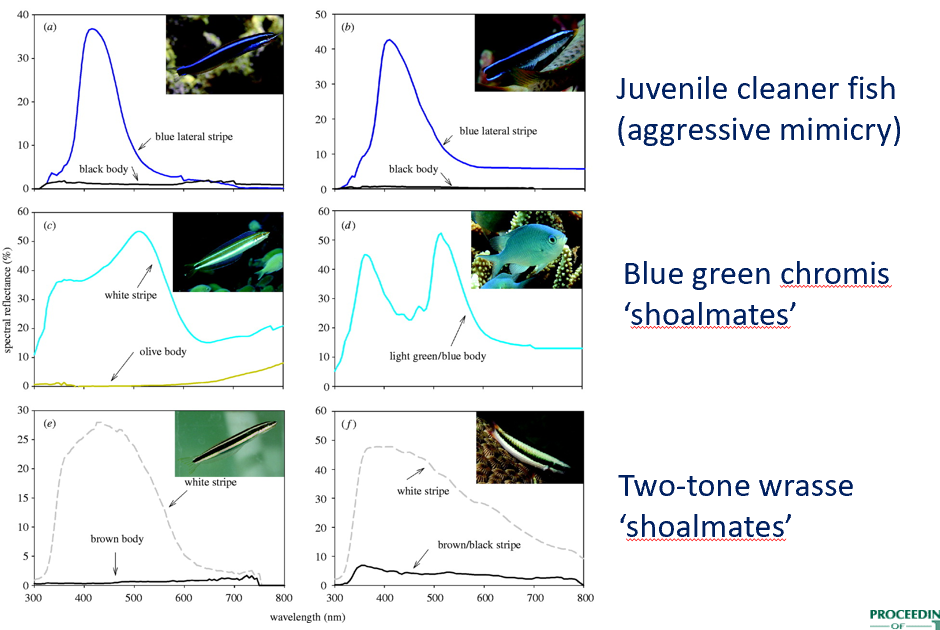
Key points of Cheney et al (2008)
Mimicry Activation & Context-Dependence
-Bluestriped fangblennies (Plagiotremus rhinorhynchos) mimic juvenile cleaner fish (Labroides dimidiatus) only in specific conditions.
-Mimicry occurs when cleaner fish are present and is more common among smaller fangblennies.
Environmental Influence on Mimicry
-The proportion of mimic fangblennies increases when cleaner fish populations are abundant.
-This suggests mimicry is adaptive and context-driven rather than a fixed trait.
Colour Accuracy & Spectral Matching
-Spectral analysis shows that mimic fangblennies closely match the colouration of cleaner fish.
-This visual similarity enhances deception, making it easier for fangblennies to approach unsuspecting prey.
Mimicry as an Adaptive Strategy
-The behaviour functions as aggressive mimicry, allowing fangblennies to get close enough to bite rather than clean.
-This strategy exploits trust-based interactions between cleaner fish and their clients.
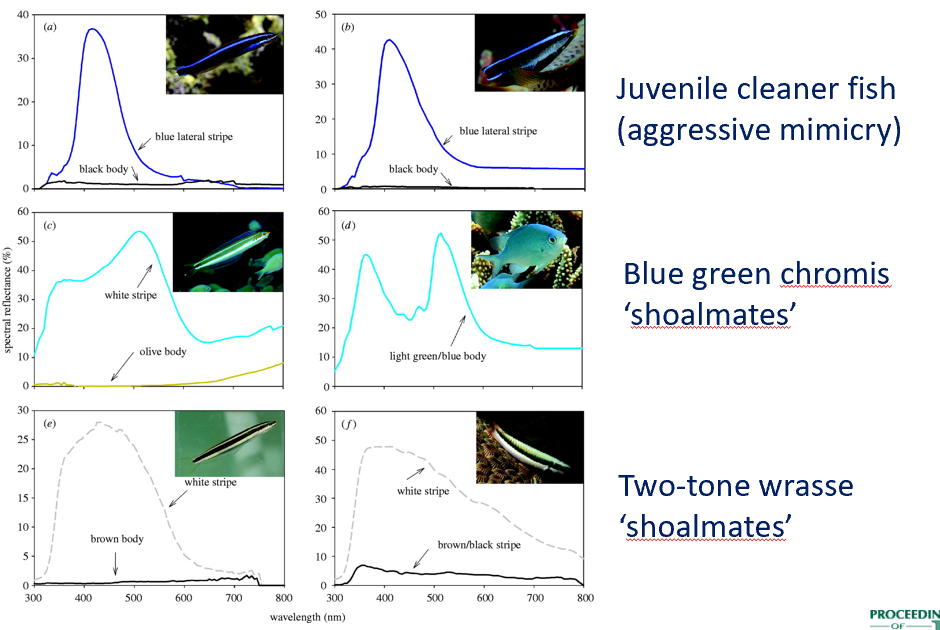
Fluorescence vS Bioluminescence
Fluorescence=Energy from a source of light is absorbed and re-emitted as a different wavelength
Bioluminescence=Excitation energy is supplied by a chemical reaction rather than light source
Chemical reaction within an organisms for bioluminescence to occur
Luciferin+Luciferase+O2=Light+Oxyluciferin
What are the 2 forms of bioluminescence?
Luminous bacteria
-Symbiotic relationship
-Bacteria get free home, oxygen and nutrients
-Fish get free light (Glow continuously)
Self-luminescence
Types of self-luminescence
Intracellular
-Light generated within fish tissue
Extracellular
-Precursors discharged separately
-Combine and shine outside body
How to fish screen bacteria luminous bacteria?
-Irises
-Chromatophores
-rotation of photophore into pocket
How do sel-luminous fish control their bioluminescence?
Neuronal or hormonal control
What is bioluminescence used for?
-Camouflage
-Communication
-Predation
What did Lawry (1974) investigate?
This study examines how lanternfish (Myctophidae) compare downwelling light from the ocean surface with their own bioluminescence to regulate visibility and camouflage.

Key points of Lawry (1974)
Counterillumination for Camouflage
-Lanternfish use ventral photophores to match the brightness of downwelling light, reducing their silhouette.
-This strategy helps them avoid detection from predators looking up in deep-sea environments.
Adaptive Bioluminescence
-They actively adjust their light output based on ambient light conditions.
-This dynamic regulation makes their camouflage more effective.
Visual Feedback Mechanism
-Evidence suggests lanternfish have a light-sensing pathway to monitor and fine-tune their bioluminescence in real time.
-This feedback system enables precise light matching.
Evolutionary Significance
-Counterillumination is a widespread strategy among deep-sea fish, demonstrating how marine species evolve to reduce predation risk.
-Understanding these mechanisms provides insights into sensory adaptations in extreme environments.

What did Martini & Haddock (2017) investigate?
This study quantifies bioluminescence across ocean depths, demonstrating its predominance as an ecological trait. Researchers analysed 17 years of video observations from remotely operated vehicles, surveying marine organisms from the surface to 3,900 meters deep.
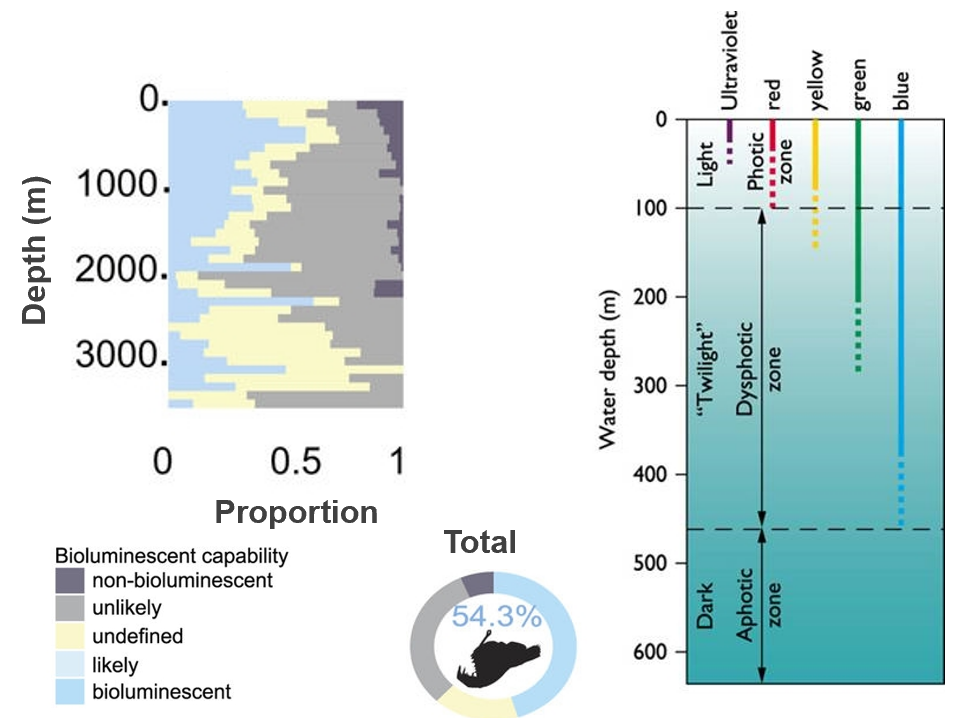
Key points of Martini & Haddock (2017)
Prevalence Across Marine Life
-76% of observed individuals exhibited bioluminescence.
-97% of cnidarians and 9 of 13 major taxonomic groups had bioluminescent species.
-Bioluminescence appears across surface to deep-sea environments.
Depth-Related Distribution
-The ratio of bioluminescent vs. non-bioluminescent organisms remained consistent across depths.
-Some groups showed depth-related shifts in bioluminescence prevalence (e.g., ctenophores, scyphozoans, chaetognaths, and crustaceans).
Ecological Functions of Bioluminescence
-Used for communication, predation, and defence, influencing species interactions.
-Plays a role in camouflage (counterillumination), prey attraction, and predator avoidance.
Significance in Oceanic Ecosystems
-Bioluminescence is a dominant trait shaping marine species distribution.
-Helps organisms adapt to extreme deep-sea environments where light is scarce.
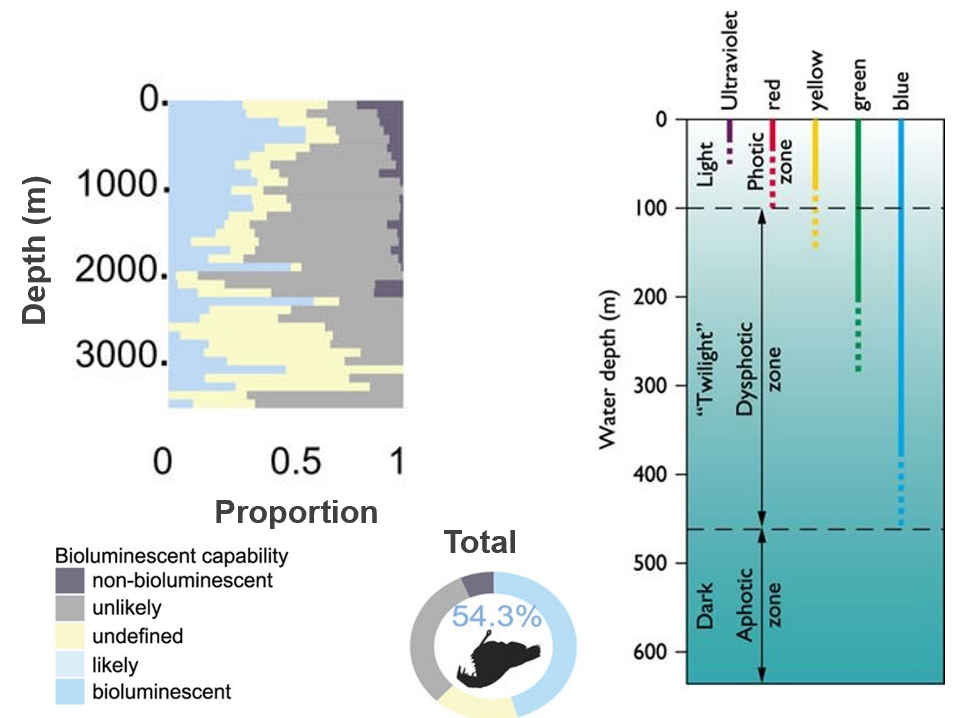
Function of intraspecific communication (Bioluminescence)
-Mutual recognition in shoal
-Courtship
-Aggression to defend territory
-To shine through predators stomach wall as warning to other fish
Function of interspecific communication (Bioluminescence)
-Distract attention of attackers
-Conspicuous warning signal
-Lures
Why do some deep sea stomiatoids have photophores that emit red light?
-Many deep sea crustaceans are red, however in the deep sea they appear black.
-So to be able to see this crustaceans they produce a red light, to show where the crustaceans are
What is the name of deep sea angler fish modified fin ray and light organ?
Modified dorsal fin ray=illicium
Light organ=esca